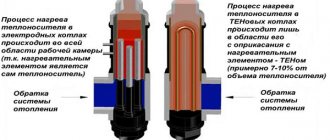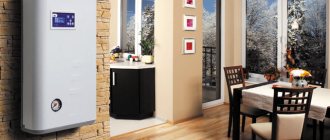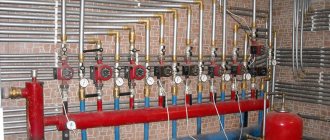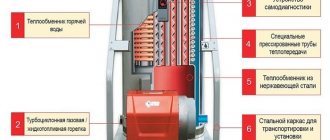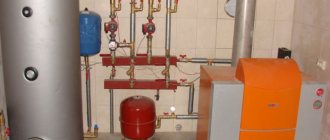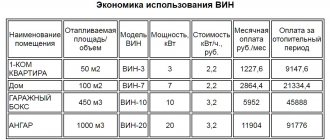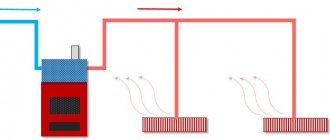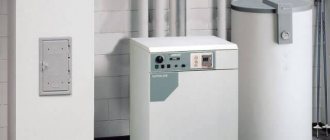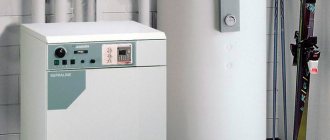Home / Gas boilers
Back
Published: 11/15/2019
Reading time: 5 min
0
16560
Many homeowners are happy to install gas boilers indoors for heating and hot water supply, so as not to depend on the whims of bad weather and pitfalls associated with the operation of municipal heating systems.
In this situation, the correct choice of boiler equipment is of great importance, for which you will need to know how to calculate the power of a gas boiler.
If it exceeds the actual heat loss of the facility, then part of the cost of generating thermal energy will be lost. And units with low heating capacity will not be able to provide households with the required amount of heat.
- 1 What is the power of a gas boiler
- 2 Calculation of the power of a gas boiler depending on the area 2.1 Calculation of a single-circuit heating boiler
- 2.2 How to calculate the power of a double-circuit boiler
- 2.3 Calculation of the power of an indirect heating boiler
Video description
In our video we’ll talk about heating in a private country house. Our guest is the author and presenter of the Teplo-Voda channel Vladimir Sukhorukov:
- A gas boiler . It is used when a gas pipeline is connected to the house. In addition, this heating option is the most economical. If the house is used for periodic residence, you can use a gas holder. But it should be taken into account that in this case the financial costs will increase significantly.
- Solid fuel boiler . For its operation, firewood, coal or briquettes are used as energy carriers. For stable operation of such a boiler there is no need to use power. If the equipment has an electronic control circuit and there is no electricity, power can be provided using a battery. But there is one drawback - you need to equip a place for fuel.
Solid fuel boiler Source mybuilding.tips
- Liquid fuel boilers . When using this heating option, you must adhere to all safety regulations, since such devices are more susceptible to accidents.
- Electrically powered boilers . Such devices are used both as an auxiliary element for heating water at a time when the main heating system is temporarily turned off, and as the main type of heating (when the use of gas or solid fuel equipment is unavailable).
See also: Catalog of companies that specialize in home insulation.
How to calculate the power of a gas boiler depending on the area of the house
Many homeowners are happy to install gas boilers indoors for heating and hot water supply, so as not to depend on the whims of bad weather and pitfalls associated with the operation of municipal heating systems.
In this situation, the correct choice of boiler equipment is of great importance, for which you will need to know how to calculate the power of a gas boiler.
If it exceeds the actual heat loss of the facility, then part of the cost of generating thermal energy will be lost. And units with low heating capacity will not be able to provide households with the required amount of heat.
What is the power of a gas boiler
The performance of a boiler unit or its power is the most important indicator of the thermal process, on which the comfort of people in heated buildings directly depends.
The power of the boiler unit is the amount of thermal energy transferred to the heated water when the energy carrier is burned in the combustion device.
The indicator is measured in Gcal or MW. For household devices, the passport usually indicates the size in kW. In order to understand the physical meaning of this indicator, we can imagine the following relationships:
1 Gcal/hour is 40.0 m3 of coolant circulating for an hour and heated in the boiler at 25 C. Conversion ratio between the values:
1.0 Gcal = 1.16 MW.
Calculation of the power of a gas boiler can be obtained using the formula:
Where:
- Рв — flow rate of circulating water, m3/hour;
- t1 – t2 – difference T of water at the inlet/outlet of the boiler unit, C.
Heat loss can be very high
A sample calculation of the power indicator, which is carried out before choosing a boiler unit:
- T of the coolant on the supply line from the boiler is 60 C.
- Coolant temperature on the return line from the network to the boiler is 40 C.
- Network consumption is 1.0 m3/hour.
Mo= (60-40)*1/1000=0.02 Gcal. * 1.16 = 0.0232 MW = 23.2 kW,
with rounding Mo = 24 kW.
Many users, in order to save money, are wondering how to reduce the power of a gas boiler. From this example it is obvious that in order to do this it will be necessary to either reduce the temperature difference or the heating area.
The second value is constant, so you can work towards reducing the temperature difference. This can be done by installing a reliable thermal protection system for your home.
Calculation of gas boiler power depending on area
In most cases, an approximate calculation of the thermal power of the boiler unit by heating area is used, for example, for a private house:
- 10 kW per 100 sq.m;
- 15 kW per 150 sq.m;
- 20 kW per 200 sq.m.
It must be taken into account that these standards were adopted back in Soviet times and do not provide for the level of thermal insulation characteristics of modern construction and installation materials. They are also not used in areas whose climate differs significantly from the conditions of the central regions of Russia and the Moscow region.
Such calculations may be suitable for a not very large building with an insulated attic floor, low ceilings, good thermal insulation, double-glazed windows, but nothing more.
According to old calculations, it is better not to do this. Photo source: porjati.ru
Unfortunately, only a few buildings meet these conditions. In order to carry out the most thorough calculation of the boiler power indicator, it is necessary to take into account the full package of interrelated quantities, including:
- atmospheric conditions in the area;
- size of residential building;
- wall thermal conductivity coefficient;
- actual thermal insulation of the building;
- gas boiler power control system;
- the amount of heat required for DHW.
Calculation of a single-circuit heating boiler
Calculating the power of a single-circuit boiler unit for a wall-mounted or floor-mounted boiler modification using the ratio: 10 kW per 100 m2 must be increased by 15-20%.
For example, you need to heat a building with an area of 80 m2.
Calculation of the power of a gas heating boiler:
10*80/100*1.2 = 9.60 kW.
In the case where the required type of device does not exist in the retail network, a modification with a larger kW size is purchased. A similar method is suitable for single-circuit heating sources, without a load on the hot water supply, and can be used as the basis for calculating gas consumption for the season. Sometimes, instead of living space, calculations are made taking into account the volume of the residential building of the apartment and the degree of insulation.
For individual premises built according to a standard design, with a ceiling height of 3 m, the calculation formula is quite simple.
Another way to calculate boiler OK
In this option, the built-up area (P) and the specific power coefficient of the boiler unit (SPC), depending on the climatic location of the facility, are taken into account.
It varies in kW:
- 0.7 to 0.9 southern territories of the Russian Federation;
- 1.0 to 1.2 central regions of the Russian Federation;
- 1.2 to 1.5 Moscow region;
- 1.5 to 2.0 northern regions of the Russian Federation.
Therefore, the formula for calculation looks like this: Mo=P*UMK/10
For example, the required power of a heating source for a building of 80 m2, located in the northern region:
Mo = 80*2/10 = 16 kW
If the owner installs a double-circuit boiler unit for heating and hot water supply, professionals advise adding another 20% of the power for water heating to the result obtained.
How to calculate the power of a double-circuit boiler
Calculation of the heating capacity of a double-circuit boiler unit is carried out based on the following proportion:
10 m2 = 1,000 W + 20% (heat loss) + 20% (DHW heating).
If the building has an area of 200 m2, then the required size will be: 20.0 kW + 40.0% = 28.0 kW
This is an approximate calculation, it is better to clarify it based on the rate of water use for hot water supply per person. The following data is provided in SNIP:
- bathroom – 8.0-9.0 l/min;
- shower installation – 9 l/min;
- toilet – 4.0 l/min;
- mixer in the sink – 4 l/min.
The technical documentation for the water heater indicates what heating output of the boiler is required to ensure high-quality water heating.
For a 200 l heat exchanger, a heater with a load of approximately 30.0 kW will be sufficient. Afterwards, the productivity sufficient for heating is calculated, and at the end the results are summed up.
Calculation of indirect heating boiler power
In order to balance the required power of a single-circuit unit running on gas fuel with an indirect heating boiler, you need to determine how much heat exchanger volume is required to provide hot water to the residents of the house. Using data on hot water consumption standards, you can easily establish that the consumption per day for a family of 4 people will be 500 liters.
The performance of an indirect heating water heater directly depends on the area of the internal heat exchanger; the larger the coil, the more thermal energy it transfers to the water per hour. You can detail such information by studying the characteristics according to the equipment passport.
Photo source: coolandtheguide.com
There are optimal ratios of these values for the average power range of indirect heating boilers and the time to obtain a given temperature:
- 100 l, Mo – 24 kW, 14 min;
- 120 l, Mo - 24 kW, 17 min;
- 200 l, Mo – 24 kW, 28 min.
When choosing a water heater, it is recommended that it heats the water in about half an hour. Based on these requirements, the 3rd option of BKN is preferable.
What to look for when choosing a boiler
According to state standards, an insulated room has a heat output of no more than 10-12 kW. In this case, a boiler with a power of 11 kW will be sufficient.
An insulated house retains heat longer Source fvn.no
Choosing which gas boiler is best for a private house of 100 sq.m. – it is necessary to take into account the characteristics of the gas pipeline. If there is a pressure in the line of at least 1.5 bar, you can opt for a model with a power of up to 14 kW. The reason for this is:
- the need for a free reserve of boiler power for optimal operation in winter;
- the ability to cover heat leaks , which are possible even with full insulation of the house;
- When using heating in the form of a warm floor (without radiators), the heat transfer of the medium is reduced.
A large range of boilers offer different functions. An installed boiler can not only heat the room, but also heat water as needed. The best option is a model that can heat up to 7 liters of water per minute. For comparison:
- an 11 kW device heats water from 3.5 to 5.5 liters per minute;
- with a power of 17 kW - water heats up from 5.5 to 9 liters per minute.
A modern alternative for providing heating and hot water supply Source teh-dom.ru
In addition, it is very important to take into account the efficiency of the boiler . The higher the indicators, the less gas is consumed, which leads to a significant reduction in the heating budget. For comparison:
- domestic brands of boilers have a coefficient of 50 - 80%;
- European – 95%.
Review of popular boilers for heating a house of 100 m2
Floor-standing gas boiler Siberia 17K
Budget line of boilers, manufactured in Russia in the city of Rostov-on-Don. Rostovgazoapparat is the largest domestic company in the gas equipment industry. It became famous for the production of boilers of the DON 16 series, RGA, characterized by high reliability and indestructibility. Many residents of our country have DON and RGA boilers installed, and they have been working properly for 30-40 years.
Thermal power: 17.4 kW Heated area: 100-200 sq m2 Purpose: heating and hot water Heat exchanger material: steel Efficiency: 90% DHW at t=35°C, 5.5 l/min
gas convection boiler Siberia_17K
Gas floor boiler RGA AOGVK 17.4
Also .
Power: 17.4 kW Heated area: up to 200 sq. m2 Purpose: heating and hot water Heat exchanger material: steel Efficiency: 90% DHW at t=35°C, 5.5 l/min
Gas floor boiler RGA AOGVK 17.4
Wall-mounted gas boiler BAXI MAIN 5 14 F
The most popular boiler manufacturer. Made in Italy. Sold in Russia since 2002. Average price 27,886.
Power: 14 kW Heated area: up to 140 sq m2 Purpose: heating and hot water Heat exchanger material: copper Efficiency: 90.7% DHW at t=35°C, 7.4 l/min
Wall-mounted gas boiler BAXI MAIN 5 14 F
Protherm Cheetah 23 MOV
Wall-mounted boilers from Protherm have gained popularity in our country due to the high quality of gas boilers and low prices. Produced in Slovakia. The average price for this boiler model is 32,723. A distinctive feature is 23 kW of power, and the hot water output is 11 liters per minute.
Power: 23 kW Heated area: up to 200 sq m2 Purpose: heating and hot water Heat exchanger material: copper Efficiency: 90.3% DHW at t=35°C, 11 l/min
Protherm Cheetah 23 MOV
Baxi NUVOLA-3 Comfort 240 Fi
Italian quality. The main advantage of this model is a built-in 60-liter boiler; this model is suitable for heating and hot water supply for a large family. The average price of a boiler is 72350.
Power: 23 kW Heated area: up to 240 sq. m2 Purpose: heating and hot water Heat exchanger material: copper Efficiency: 92.9% Built-in boiler: 60 liters of hot water at t=35°C, 14 l/min
Baxi NUVOLA-3 Comfort 240 Fi
Main characteristics
To find out which gas boiler to choose for heating a house of 100 square meters, you should consider their main characteristics.
First of all, this is the method of installing the equipment:
- floor-mounted boiler options;
- wall installation option;
- parapet connection.
The mounted boiler is not the most powerful, but fits harmoniously into the interior Source sovetclub.ru
Then you should pay attention to the number of circuits:
- single-circuit ones are used exclusively for heating the room;
- double-circuit ones are used for space heating and water heating.
It is important to pay attention to the type of burner:
- normal - oxygen is supplied to the fire due to natural draft;
- inflatable - air is pumped by a fan;
- combined.
There are several ways to adjust the boiler power per 100 sq.m:
- Single stage. After reaching the set temperature, it operates on the fuse.
- Two-stage. The set temperature is reached, after which it switches to 40% power.
- Smooth two-stage. It works like the previous option, but with a smooth change of modes.
- Modulated - works in several modes.
Camera type being considered
- open option. For its operation, air comes directly from the room where the device is located, this process occurs naturally;
- closed option. Using a special pipe, air is pumped from the outside of the room.
Starting a gas boiler Source en.decorexpro.com
The type of draft is as follows:
- normal - due to convection;
- injection - using fans.
The burners are ignited as follows:
- electric ignition - powered from the network;
- piezo ignition – a spark is generated by a piezoelectric element;
- lighting with matches.
And you should definitely take into account the material that was used to make the heat exchanger:
- steel;
- cast iron;
- copper.
Calculation of the power of a gas boiler for a private house - for single and double circuit circuits
A competent choice of boiler will allow you to maintain a comfortable indoor temperature during the winter season.
A large selection of devices allows you to most accurately select the desired model depending on the required parameters.
But in order to provide warmth in the house and at the same time avoid unnecessary expenditure of resources, you need to know how to calculate the power of a gas boiler for heating a private house.
A floor-standing gas boiler has greater power Source termoresurs.ru
The main characteristics affecting the boiler power
The boiler power indicator is the main characteristic, however, the calculation can be carried out using different formulas, depending on the configuration of the device and other parameters. For example, a detailed calculation may take into account the height of the building and its energy efficiency.
Varieties of boiler models
Boilers can be divided into two types depending on the purpose of application:
- Single-circuit
– used only for heating; - Double-circuit
– used for heating, as well as in hot water supply systems.
Units with one circuit have a simple structure, consisting of a burner and a single heat exchanger.
Single-circuit wall-mounted gas boiler Source ideahome.pp.ua
In dual-circuit systems, the water heating function is primarily provided.
When using hot water, the heating is automatically turned off while hot water is being used so that the system is not overloaded. The advantage of a dual-circuit system is its compactness.
Such a heating complex takes up much less space than if the hot water supply and heating systems were used separately.
Boiler models are often divided by placement method.
Depending on their type, boilers can be installed in different ways. You can choose a wall-mounted or floor-mounted model.
It all depends on the preferences of the owner of the house, the capacity and functionality of the room in which the boiler will be located. The installation method of the boiler is also affected by its power.
For example, floor-standing boilers have more power compared to wall-mounted models.
In addition to fundamental differences in purpose of use and placement methods, gas boilers also differ in control methods. There are models with electronic and mechanical control. Electronic systems can only operate in homes with constant access to the power grid.
Double-circuit gas boiler with indirect heating boiler Source norogum.am On our website you can find contacts of construction companies that offer house insulation services. You can communicate directly with representatives by visiting the “Low-Rise Country” exhibition of houses.
Typical device power calculations
There is no single algorithm for calculating both single- and double-circuit boilers - each system must be selected separately.
Formula for a typical project
When calculating the required power for heating a house built according to a standard design, that is, with a room height of no more than 3 meters, the volume of the premises is not taken into account, and the power indicator is calculated as follows:
- Determine the specific thermal power: Um = 1 kW/10 m2;
- Next, calculate the required power to heat the house.
Rm = Mind * P * Kr, where
P – a value equal to the sum of the areas of heated premises,
Kr is a correction factor that is taken in accordance with the climatic zone in which the building is located.
Some coefficient values for different regions of Russia:
- Southern – 0.9;
- Located in the middle zone – 1.2;
- Northern – 2.0.
- For the Moscow region, a coefficient value of 1.5 is taken.
This technique does not reflect the main factors influencing the microclimate in the house, and only approximately shows how to calculate the power of a gas boiler for a private home.
Some manufacturers issue recommendations, but for accurate calculations they still recommend contacting specialists Source parki48.ru
Example calculation for a single-circuit device installed in a room with an area of 100 m2, located in the Moscow region:
Рм = 1/10 * 100 * 1.5 = 15 (kW)
Calculations for dual-circuit devices
Double-circuit devices have the following operating principle. For heating, water is heated and supplied through the heating system to radiators, which release heat to the environment, thereby heating the rooms and cooling them. When cooling, the water flows back to be heated.
Thus, water circulates along the heating system circuit, and goes through heating cycles and transfer to the radiators. At the moment when the ambient temperature becomes equal to the set one, the boiler goes into standby mode for some time, i.e.
Temporarily stops heating the water, then starts heating again.
For domestic needs, the boiler heats water and supplies it to the taps, and not to the heating system.
Double-circuit heating system Source idn37.ru
When calculating the power of a device with two circuits, another 20% of the calculated value is usually added to the resulting power.
An example of calculation for a two-circuit device that is installed in a room with an area of 100 m2; the coefficient is taken for the Moscow region:
- Рм = 1/10 * 100 * 1.5 = 15 (kW)
- Ritogovaya = 15 + 15*20% = 18 (kW)
This might be interesting!
In the article at the following link, read about installing a gas boiler in a private house.
Additional factors taken into account when installing the boiler
In construction, there is also the concept of energy efficiency of a building, that is, how much heat a building releases to the environment.
One of the indicators of heat transfer is the dissipation coefficient (Kp). This value is a constant, i.e. constant and does not change when calculating the level of heat transfer of structures made of the same materials.
It is necessary to take into account not only the power of the boiler, but also the possible heat loss of the building itself Source pechiudachi.ru
For calculations, a coefficient is taken, which, depending on the building, can be equal to different values and the use of which will help you understand how to calculate the power of a gas boiler for a home more accurately:
- The lowest level of heat transfer, corresponding to a K value from 0.6 to 0.9, is assigned to buildings made of modern materials, with insulated floors, walls and roofs;
- Kr is equal to from 1.0 to 1.9, if the external walls of the building are insulated and the roof is insulated;
- Kr is equal to from 2.0 to 2.9 in houses without insulation, for example, brick houses with single masonry;
- Kr is equal to from 3.0 to 4.0 in non-insulated rooms, in which the level of thermal insulation is low.
The level of heat loss Qt is calculated in accordance with the formula:
Q t
= V * P t * k / 860, where
V –
is the volume of the room
Pt – p
temperature difference calculated by subtracting the minimum possible air temperature in the region from the desired room temperature,
k – safety factor.
Modern gas boiler Source tr.decorexpro.com
The boiler power, when taking into account the dissipation coefficient, is calculated by multiplying the calculated level of heat loss by the safety factor (usually from 15% to 20%, then multiply by 1.15 and 1.20, respectively)
This technique allows you to more accurately determine productivity and, therefore, approach the issue of choosing a boiler as efficiently as possible.
What happens if you incorrectly calculate the required power
It is still worth choosing a boiler so that it matches the power required to heat the building. This will be the best option, since first of all, purchasing a boiler that does not match the power level can lead to two types of problems:
- A low-power boiler will always work at the limit, trying to heat the room to the set temperature, and can quickly fail;
- A device with an excessively high power level costs more and, even in economy mode, consumes more gas than a less powerful device.
Calculator for calculating boiler power
For those who do not like to do calculations, even if they are not very complicated, a special calculator will help you calculate a boiler for heating your home - a free online application.
Interface of an online calculator for calculating boiler power Source idn37.ru
As a rule, the calculation service requires you to fill out all the fields, which will help you make the most accurate calculations, including the power of the device and the thermal insulation of the house.
To obtain the final result, you will also need to enter the total area that will require heating.
Next, you should fill out information about the type of glazing, the level of thermal insulation of walls, floors and ceilings. As additional parameters, the height at which the ceiling is located in the room is also taken into account, and information about the number of walls interacting with the street is entered. The number of floors of the building and the presence of structures on top of the house are taken into account.
After entering the required fields, the calculation button becomes “active” and you can get the calculation by clicking on the corresponding button. To check the information received, you can use calculation formulas.
To see how to calculate the power of a gas boiler, watch the video:
Advantages of using gas boilers
Gas equipment has a number of advantages and disadvantages. The advantages include:
- possibility of partial automation of the boiler operation process;
- unlike other energy sources, natural gas has a low cost;
- The devices do not require frequent maintenance.
The disadvantages of gas systems include the high risk of gas explosion, however, with proper storage of gas cylinders and timely maintenance, this risk is minimal.
On our website you can familiarize yourself with construction companies that offer services for connecting electrical and gas equipment. You can communicate directly with representatives at the Low-Rise Country exhibition of houses.
Conclusion
Despite the apparent simplicity of the calculations, we must remember that gas equipment must be selected and installed by professionals. In this case, you will receive a trouble-free device that will work properly for many years.
Read later
We will send the material by email
Author of the article
Internal communications specialist, residential facilities
Dmitry Nikitin
Source: https://m-strana.ru/articles/raschet-moshchnosti-gazovogo-kotla-dlya-chastnogo-doma/
Review of some types of heating devices
To understand which boiler to choose for heating a house of 100 square meters, you should consider some options.
AOGV 11.6(M)
This is a domestically manufactured two-hull device, has a power of 11.6 kW, and is capable of heating water up to 2 l/min. Floor mounted boiler. The price is within 17,000 rubles.
Operation diagram of a classic gas boiler with a traditional layout AOGV 11.6 Source master-electrician.ru
Calculation taking into account the area of the room
How to include information about ceiling height or climate in this formula?
This has already been taken care of by specialists who have empirically derived coefficients that allow certain adjustments to be made to the calculations. So, the above norm is 1 kW per 10 sq. meters - implies a ceiling height of 2.7 meters. For higher ceilings, it will be necessary to calculate the correction factor and recalculate. To do this, the ceiling height must be divided by the standard 2.7 meters.
We propose to consider a specific example: the ceiling height is 3.2 meters. The calculation of the coefficient looks like this: 3.2/2.7=1.18. This figure can be rounded to 1.2. How to use the resulting figure? Let us remind you that for heating a room of 160 sq. meters you need 16 kW of power. This indicator must be multiplied by a factor of 1.2. The result is 19.2 kW (rounded to 20 kW).
Next, we should add climatic features. For Russia, certain coefficients apply depending on the location:
- in the northern regions 1.5–2.0;
- in the Moscow region 1.2–1.5;
- in the middle zone 1.0–1.2;
- in the south 0.7–0.9.
However, that's not all. The above values can be considered correct if a factory or home-made boiler will work exclusively for heating. Let's assume that you want to assign water heating functions to it. Then we add another 20% to the final figure. Take care of power reserves for peak temperatures in severe frosts, and this is another 10%.
You will be surprised by the results of these calculations. Let's give specific examples.
A house in central Russia with heating and hot water will require 28.8 kW (24 kW + 20%). In cold weather, another 10% of power is added 28.8 kW + 10% = 31.68 kW (rounded to 32 kW). As you can see, this last figure is 2 times higher than the original one.
Calculations for a house in the Stavropol region will be slightly different. If you add the power for water heating to the above indicators, you will get 19.2 kW (16 kW + 20%). And another 10% “reserve” for cold will give you a figure of 21.12 kW (19.2+10%). Round up to 22 kW. The difference is not so great, but, nevertheless, these indicators must be taken into account.
As you can see, when calculating the power of a heating boiler, it is very important to take into account at least one additional indicator
Please note that the formula regarding heating for an apartment and the same for a private house are different from each other. In principle, when calculating this indicator for an apartment, you can follow the same path, taking into account the coefficients reflecting each factor
However, there is an easier and faster way that will allow you to make adjustments in one go.
For apartments this figure will be different. If there is a heated room above your apartment, then the coefficient is 0.7, if you live on the top floor, but with a heated attic - 0.9, with an unheated attic - 1.0. How to apply this information? The boiler power, which you calculated using the above formula, must be adjusted using these coefficients. This way you will receive reliable information.
Before us are the parameters of an apartment located in a city in central Russia. To calculate the volume of the boiler, we need to know the area of the apartment (65 square meters) and the height of the ceilings (3 meters).
First step: determining the power by area - 65 m2/10 m2 = 6.5 kW.
Second step: adjustment for the region - 6.5 kW * 1.2 = 7.8 kW.
Third step: the gas boiler will be used to heat water (add 25%) 7.8 kW * 1.25 = 9.75 kW.
Fourth step: adjustment for extreme cold (add 10%) - 7.95 kW*1.1=10.725 kW.
The result must be rounded, and the result will be 11 kW.
To summarize, we note that these calculations will be equally correct for any heating boilers, regardless of what type of fuel you use. Exactly the same data is relevant for an electric heating device, a gas boiler, and one that runs on liquid energy. The most important thing is the efficiency and performance of the device. Heat loss does not depend on its type.
Heat loss accounting
Without taking into account heat loss, it is difficult to correctly calculate the boiler power
. When starting to develop an autonomous heating system, you must first find out how much heat is lost to the street during the most severe frosts through the so-called enclosing structures. These include walls, windows, floors and roofs. Only after determining the amount of heat loss will it be possible to worry about selecting a heat source of appropriate power. It should be taken into account that the loss of heat from a building in the winter season occurs not only through the enclosing structures. A significant part of the generated heat (up to 30%) is spent on heating cold air coming from the street due to natural ventilation.
The total amount of heat required to heat the room is determined by the formula:
Q = Qdesign + Qair, where:
- Qconstruct – the amount of heat lost through a similar structure, W;
- Qair – the amount of heat consumed to heat the air coming from the street, W.
By summing up the values obtained as a result of calculations, the total heat load on the heating system of the entire building is determined.
All measurements are carried out on the outside of the building, necessarily taking into account its corners. Otherwise, the calculation of heat loss will be inaccurate.
There are other ways of heat leakage in rooms, for example, through a kitchen hood, open doors and windows, cracks in structures, etc. However, the amount of heat lost for these reasons practically does not exceed 5% of the total heat loss and is therefore not taken into account in calculations .
Calculation of heat loss through building envelopes
The complexity of the calculation lies in the fact that it must be carried out for each room separately, carefully inspecting, measuring and assessing the condition of each of its elements adjacent to the environment. Only in this case can you take into account all the heat leaving the house.
Based on the results of the measurements, the area S of each element of the enclosing structure is determined, which is then inserted into the basic formula for calculating the amount of lost thermal energy:
Qconstruct = 1/R*(Tv-Tn)*S*(1+Σβ), R = δ/λ; Where:
- R – thermal resistance of the construction material, m sq.°C/W;
- δ – thermal conductivity of the construction material, W/m°C);
- λ – thickness of the construction material, m;
- S – area of the external fence, sq. m.;
- Tb – indoor air temperature, °C;
- Tn – lowest air temperature in winter, °C;
- β – heat loss, which depends on the orientation of the building.
If the structure consists of several materials, for example, a brick wall with insulation, the value of thermal resistance R is calculated separately for each of these materials and then summed up.
Heat losses, depending on the orientation of the building, are selected based on where the enclosing element is oriented:
- to the north side – β = 0.1;
- to the west or southeast – β = 0.05;
- to the south or southwest – β = 0.
The calculation of heat losses through the elements of the building envelope is carried out for each room in the building, and then summing them up, the predicted value of the total heat losses in it is obtained. After this, they proceed to the calculation in the next room. As a result of the work carried out, the home owner will be able to identify ways of maximum heat leakage and eliminate the causes of their occurrence.
Calculation of heat consumed to heat ventilation air
The amount of heat that is spent on heating ventilation air reaches, in some cases, 30% of the total thermal energy losses. This is a fairly large value that is inappropriate to ignore. To calculate the amount of heat that will be forced to be spent on heating the supply air, the formula is used:
Qair = c*m* (Tv-Tn), where:
- c is the heat capacity of the air mixture, the value of which is 0.28 W/kg°C;
- m – mass flow of air entering the room from the street, kg.
The mass flow of air entering the room from the outside is determined by assuming that the air is renewed throughout the entire house once every hour. In this case, by adding up the volumes of all rooms, the volumetric air flow rate is obtained. Then, using the air density value, its volume is converted to mass. Here you need to take into account the fact that the density of air depends on its temperature.
| Supply air temperature ºС | — 25 | — 20 | — 15 | — 10 | -5 | 0 | + 5 | + 10 |
| Density, kg/m3 | 1,422 | 1,394 | 1,367 | 1,341 | 1,316 | 1,290 | 1,269 | 1,247 |
Substituting all known quantities into the above formula, the amount of heat required to heat the supply air is determined.
Common mistakes
Calculation of an autonomous heating system is a complex process consisting of several interrelated, step-by-step procedures:
- Calculation of heat losses of an object.
- Determination of the temperature regime of individual rooms and the building as a whole.
- Calculation of the power of heating radiator batteries.
- Hydraulic calculation of the heating system.
- Calculation of heating boiler power.
- Determination of the total volume of the autonomous heating system.
Thermal calculation of a heating system is not theoretical research, but an accurate and well-founded result, the practical implementation of which will allow you to correctly select all the necessary components and set up an effective heating system that functions without problems for many years.
The main mistake that many owners of private houses make is ignoring some stages of the calculation. They believe that to solve the problem it is enough to choose a more powerful boiler, focusing only on the data of the approximate calculation of its power based on the area of the room. This approach threatens with unnecessary operating costs and often leads to the fact that the boiler will work constantly, the radiator batteries will be hot, and the room will be cold. In this case, it is necessary to return to the original state and perform a full calculation of the heating system. Only after this can we begin to eliminate the shortcomings caused by critical errors in calculations.
